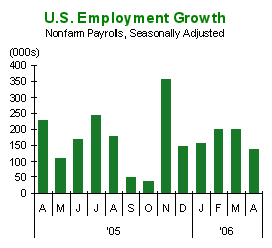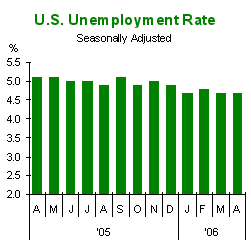|
May 10, 2006
Income Gains
Written by Jeff Thredgold, CSP, President, Thredgold Economic Associates
The American job market was a bit of a mixed bag in April, with lower-than-expected net job creation. Other factors, however…including rising wages and a longer average work week…told a story of solid economic growth, with rising wages being both good news (for workers) and bad news (for the Fed).
Employment gains in April came in at 138,000 net new jobs, below Wall Street’s consensus view of a gain closer to 200,000. In addition, employment gains of the two prior months were revised lower by 36,000 jobs, collectively.
Both February and March now show 200,000 net new jobs created (at least until the Bureau of Labor Statistics revises the data again). The nation’s unemployment rate remained at a near five-year low of 4.7%.
More $$
April employment gains were the weakest in six months. However, wage gains were the strongest in almost five years. The average hourly wage rose nine cents (up 0.5%) to $16.61 per hour. The year-over-year gain is now 3.8%, the strongest 12-month gain since an identical rise in August 2001.
 In addition, the average work week rose from 33.8 hours to 33.9 hours. The 33.8 hour week had been unchanged over the past seven months. This gain, while seemingly immaterial on the surface, is actually the equivalent of 300,000 new jobs in the economy (The Wall Street Journal). In addition, the average work week rose from 33.8 hours to 33.9 hours. The 33.8 hour week had been unchanged over the past seven months. This gain, while seemingly immaterial on the surface, is actually the equivalent of 300,000 new jobs in the economy (The Wall Street Journal).
A lengthening work week many times suggests that companies are having a difficult time in hiring new workers and are thus forced to keep current workers on the clock for longer periods. Such an increase in the work week may portent stronger employment gains in coming months.
The combination of a higher hourly wage and a slightly longer work week led average weekly earnings 0.8% higher, the biggest gain since August 1997. Average weekly earnings are now up 4.1% over the past 12 months, the largest increase in eight years.
Rising wages are obviously a favorable development for workers, with all of us facing higher energy costs. Stronger wage gains, should they continue, will help consumers maintain spending levels.
At the same time, faster growth in wages is potentially inflationary as companies attempt to “pass through” higher wages to consumers and other firms in the form of higher prices. Many firms are already passing through higher energy costs to their customers via fuel surcharges.
This issue of tighter labor availability, and the need in many cases for employers to boost wage levels in order to attract and/or retain workers, is one that various Federal Reserve officials have mentioned frequently in Congressional testimony and speaking presentations over the past year…
…How to offset rising wages besides raising prices?
Gains in worker productivity have been…and remain…the key
Productivity
In theory, let’s say that Company A is able to boost the productivity of the average worker by four percent per year, via better use of technology and well thought-out improvements to work methods. In this case, the company can boost wages by 4.0% and not have to boost product or service prices in order to maintain the same level of profitability.
|
Where the Jobs Were
The nation’s goods production sector added 37,000 net new jobs in April, led by the addition of 19,000 new manufacturing jobs. The manufacturing gain was the strongest in nearly two years. The construction sector added another 10,000 net new jobs.
The natural resource sector added 8,000 new jobs in April. It’s no secret that the oil and gas exploration and production sector could add substantially more jobs IF they could find people to hire. The vast majority of workers with oil/gas skills are already working. Many will look to retirement over the next decade.
The issue? Despite high wage levels, there are not exactly a large number of young people anxious to get their hands dirty in the oil & gas sector. Labor shortages are only likely to get worse.
The nation’s service providing sector added 101,000 net new jobs in April, led by the addition of 35,000 net new jobs in health care & education. An additional 28,000 new jobs were added in professional & business services, with 26,000 net new jobs in the financial sector and 20,000 new leisure & hospitality jobs.
The retail trade sector lost an estimated 36,000 jobs in April, accounting for much of the lower-than-expected overall rise. The government sector added 7,000 net new jobs in April.
|
|
Conversely, let’s say Company B is only able to boost average worker productivity by two percent per year. However, tightening labor markets compel the company to boost wages by 4.0% in order to attract/retain quality workers. It must then either boost prices/services by 2.0% or see its profitability decline.
Worker productivity in the U.S. economy rose at a 3.2% annual pace during 2006’s first quarter, a sharp improvement from the prior quarter’s pace. The 2.4% productivity rise over the past 12 months is in line with historic trends, but weaker than the 3.5% average annual pace since 2001.
This 3.5% average productivity rise of the past four years was the strongest such pace in more than 50 years. Theory, and reality, also suggests that as the economic expansion moves further into its cycle, the easily obtained gains in worker productivity have already been achieved. This notion is one reason the Fed is very concerned about climbing wages pushing prices of goods and services higher in the economy.
At the Fed
Wednesday, May 10 presumably saw the Fed tighten monetary policy for a 16th consecutive time, taking the important federal funds rate to 5.00%. By comparison, the rate was at a 46-year low of 1.00% between June 2003 and June 2004.
This report was written prior to the Fed’s 2:15PM Eastern Time Wednesday announcement of the latest tightening move, as well as the latest Fed statement. The Fed, and its new occupant of the Big Chair, Ben Bernanke, will have a difficult time in determining whether additional tightening moves are warranted in coming months. It’s important to note that the Fed at this time DOES NOT know whether additional moves will occur, or whether Ben and his colleagues will move to the sidelines.
Ongoing economic data will drive the Fed’s actions……stay tuned

“Tea”ser
Why doesn’t glue stick to the bottle?
—Scott Friedman
|

